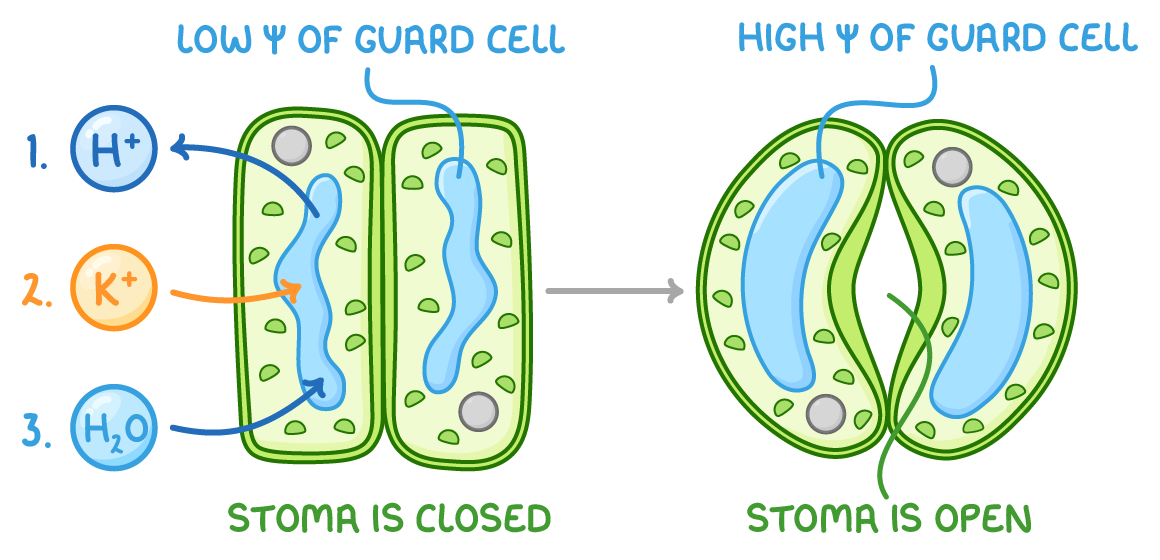Homeostasis in Plants
This lesson covers:
- The role of stomata in homeostasis in plants
- The adaptations of guard cells
- What triggers stomata to open and close
- Mechanism of stomatal opening
- Mechanism of stomatal closure
- The role of abscisic acid in stomatal closure
The role of stomata in homeostasis
Stomata are critical in regulating the exchange of gases and water vapour between plant leaves and the environment, which is essential for photosynthesis and transpiration.
They adjust the rates of these processes to balance the need for CO2 in photosynthesis with water conservation, thus playing a vital role in the plant's homeostasis.
The adaptations of guard cells
Guard cells are uniquely adapted to their role in opening and closing stomata.
Adaptations of guard cells:
- Outer walls for structural support, with waxy cell walls prevent water loss.
- Elastic inner walls for flexibility.
- The inner wall is thicker than the outer wall, which allows the cells to curve and open the pore.
- Many mitochondria release energy that drives opening and closing of the pore.
- Membrane folds that increase surface area for ion transport.
- Dense distribution of chloroplasts for photosynthesis within guard cells.
- Starch grains that adjust in size to aid in osmotic balance.
- Multiple small vacuoles for efficient compartmentalisation and osmoregulation.
Cellulose microfibrils prevent the expansion of the guard cells in all directions, directing cells to increase in length, not diameter. This means that the outer wall stretches more than the inner walls when guard cells become turgid, causing the guard cells to curve apart and open the stoma.
What triggers stomata to open and close
There are different environmental cues that can trigger either stomatal opening or stomatal closure, depending on what is most beneficial to the plant's survival.
Factors that trigger stomatal opening
Stomata open in response to environmental cues that indicate favourable conditions for photosynthesis.
Factors that cause stomata to open include:
- Increased light intensity, indicating photosynthesis is occurring.
- Decreased CO2 levels within the leaf air spaces, indicating more CO2 is needed for photosynthesis.
Factors that trigger stomatal closure
Stomata close to conserve water and energy when conditions are unfavourable.
Factors that cause stomata to close include:
- Decreased light intensity indicating photosynthesis stopping.
- Increased CO2 levels as a result of reduced photosynthesis.
- Decreased humidity, high temperatures, or water stress, which increase the risk of dehydration and could lead to excessive water loss via transpiration.
The mechanism of stomatal opening

The opening of stomata involves several steps:
- Activation of ATP-dependent proton pumps reduces hydrogen ion (H+) concentration inside guard cells.
- Lower H+ triggers potassium ion (K+) channels to open and K+ enters the guard cells, down an electrochemical gradient. Starch in guard cells is also broken down to form negatively charged malate ions.
- The increased concentration of malate ions and K+ lowers the water potential (Ψ) inside the guard cells, while maintaining the electrical balance, causing water to enter via osmosis.
- As guard cells absorb water, they become turgid and curve apart, opening the stoma.
The mechanism of stomatal closure
The closure of stomata involves several steps:
- Proton pump activity stops, preventing export of H+ from the guard cells.
- A reversal in the water potential gradient prompts K+ to exit the guard cells.
- Malate ions are transported into chloroplasts and converted into starch, or removed from the cell.
- The water potential increases in the guard cells and water leaves by osmosis, reducing the turgor pressure in the cells.
- The guard cells become flaccid and the stoma closes.
The role of abscisic acid in stomatal closure
Abscisic acid (ABA) is a plant hormone that controls the response of plants to environmental stresses such as shortage of water or high temperatures by closing stomata.
ABA affects stomatal closure as follows:
- ABA levels increase when water availability is low.
- ABA binds to specific receptors on guard cell membranes.
- This inhibits proton pumps, stopping the active transport of H+ out of the cell.
- ABA triggers Ca2+ to enter the guard cell cytoplasm.
- This causes ion channels to open in the membrane, lead to the efflux of negatively charged malate ions and K+.
- This increases the water potential inside the guard cells, causing water to exit the guard cells and they become flaccid.
- The loss of turgor pressure in the guard cells causes the stomatal pore to close, conserving water.